Dubrovnik's Red History Museum Becomes a Must-See
ZAGREB, July 7, 2019 - The Red History Museum, the newest museum in Dubrovnik, has in a short time become an unavoidable cultural place to visit in that southern city, which itself is a museum.
One of Dubrovnik's 19 museums, the Red History Museum was opened in April this year and it features an exhibition that describes everyday life in communist Yugoslavia.
Visitors to the popular international travel website TripAdvisor recommend it as one of the three museums and one of the first ten places in Dubrovnik to visit.
Located in the city's Gruž industrial district, in the inconspicuous basement of the Factory of Carbon Graphite Products, once the city's most successful socialist factory, the museum was established by five young enthusiasts, who financed the project with their own money.
One of them, Krešo Glavinić, said he was happy that in only one month the museum had received as many comments as some museums received in a year.
Two of some 300 items on display are a red Yugo 45 car and a K67 kiosk, which was designed by Slovenian Saša Maechtig and until 1990 was exported to many countries, ending up in the depot of New York's Museum of Modern Art (MoMA).
The museum holds about 1,000 Yugoslav-era items that were bought at flea markets or on the internet.
The choice of exhibits, the museum's founders say, was determined in line with work done by prominent researchers of political and cultural history and the history of tourism and everyday life.
"We bought a basketball with Dražen Petrović's signature from a collector in Slovenia and a portable Iskra TV set from a Roma in Pančevo," Glavinić said.
The permanent exhibition has been designed in such a way to show an average socialist apartment.
The exhibits, interactive solutions and extended reality serve to acquaint visitors with socialist urban planning and housing construction, self-government and associated work, economic reforms, women's rights, the 1971 movement calling for greater emancipation of Croatia as a federal republic, as well as with film, media, education, sports etc.
The exhibition also includes items testifying to the politicisation of the youth, youth labour drives, the cult of Tito and the 1980s crisis, which serve as an introduction to the last section of the exhibition, entitled Dealing With Enemies and showing artefacts of secret services and stories about the red era totalitarianism, dissidents and the authorities' attitude to religion.
"While working on the museum's concept, we had in mind people without any experience related to socialism - young people, tourists and students. The purpose of the exhibition is to intrigue them without making any final value judgements," Glavinić said, adding that talks were underway with schools and universities, not only from Dubrovnik or Croatia, on organised visits.
More Dubrovnik news can be found in the Lifestyle section.
Croatian Airports Record Busiest June in History
July 5, 2019 - It’s another busy year for Croatian airports, which saw the busiest June in history.
Rijeka Airport continues to grow each year and saw a record increase in passengers and operations compared to June 2018, reports Novi List.
"After the successful 2018, when Rijeka Airport broke all records, achieving a total turnover of 183,606 passengers and a growth in traffic of almost 30%, this summer season also opened with great news.
Namely, Rijeka Airport can boast the busiest June to date and has increased passenger traffic by 37% as compared to June 2018, while traffic operations accounted for 40% higher turnover compared to the previous year,” the airport said.
These excellent achievements are an excellent introduction to the season, in which they expect 200,000 passengers.
The reason for the increase is the introduction of new lines for Belgrade, Munich, and Marseille, but also an increase in the number of existing carriers, in particular, Transavia for Eindhoven, which increased by 350% compared to last season's number of operations,” they added.
Avio Radar reports that Dubrovnik Airport also recorded a stellar June, which saw 415,876 passengers, which is 50,528 more passengers than last year. Thus, Dubrovnik Airport welcomed a passenger growth of 13.83% last month.
The first direct line from the United States to Croatia operated by American Airlines has significantly contributed to Dubrovnik’s success.
Dubrovnik Airport has recorded an increase in traffic in each month this year. In the first half of the year, 1,059,564 passengers traveled through the airport, which is 157,184 more passengers than last year, or a growth of 17.42%.
Split Airport welcomed 513,706 passengers or an increase of 8.2% for a record June, and in the first six months of 2019, they welcomed 1,102,118 passengers, which is up 8%.
Ex Yu Aviation reports that Zagreb Airport saw 336,618 passengers in June, which is an increase of 1.5% compared to last year. In the first half of the year, Zagreb Airport handled 1,534,105 passengers, which is up 4.2%, or an additional 62,477 compared to 2018.
To read more about travel in Croatia, follow TCN’s dedicated page.
Is Korcula Really a 'Mini Dubrovnik'? Please, May It Never Be
July 4, 2019 - Two idyllic and historic stone towns on the Adriatic, but is Korcula really a 'mini Dubrovnik'?
The Dalmatian coast in the summer is a fascinating - and spectacular - place to be. Endless sunshine, divine beaches, the inviting water and plenty of historic towns to savour. From mass tourism to something a little more private, there is plenty of choice depending on your tastes and budget.
I have spent the last couple of weeks travelling extensively along the coast - Kornati islands, Zadar, Split, Hvar, Korcula and Dubrovnik, and it has been an interesting exercise observing the various destinations close up. And the differences are stark, as are the approaches to tourism. One of the most thought-provoking for me at least was a night in Korcula, sometimes known as a 'mini Dubrovnik' followed by a night in the Pearl of the Adriatic itself.
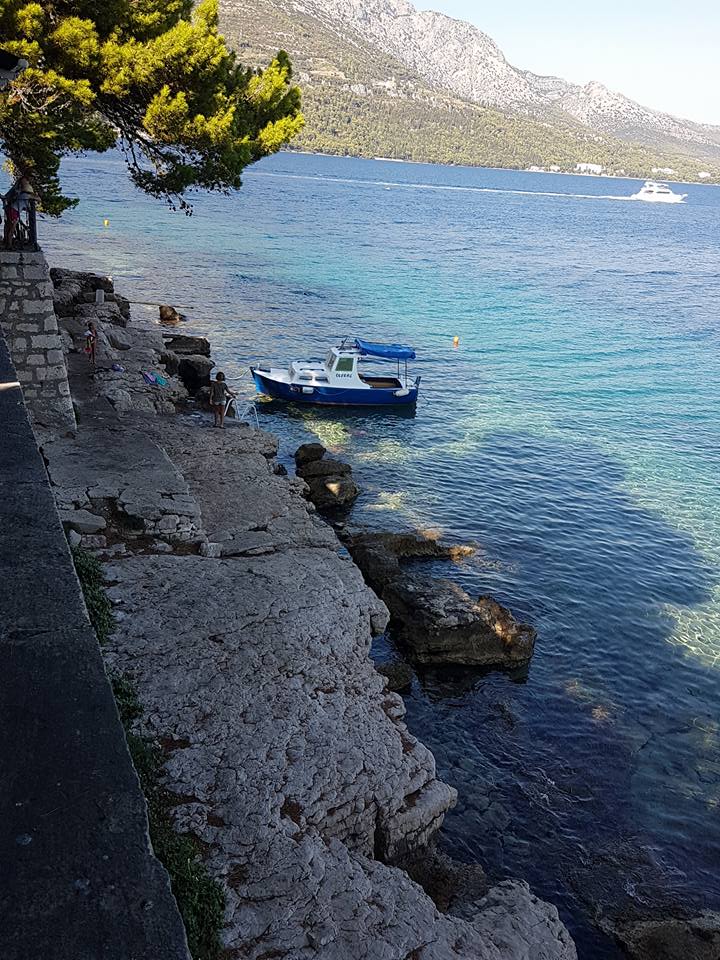
Korcula Town is a relatively late discovery for me, which is all the more strange as I lived on the neighbouring island for 13 years. You can read about the first visit two years ago here. Every time I return, something impresses me more, and I was intrigued on this last visit to be able to compare it to Dubrovnik where I would be spending the following day.
On paper, and visually, the 'mini Dubrovnik' name has some merit. Both are imperious walled towns jutting out into the Adriatic. Both have rich traditions and centuries of fascinating history. Both were the first in the world to abolish slavery - interestingly, Korcula some 200 years before Dubrovnik, way back in 1214.
But there, at least for me, that is where the comparisons end, especially when one looks at the approach to tourism.
A lot has been written about overtourism in recent weeks, the latest a piece in The Daily Telegraph by Jane Foster, who revisited Dubrovnik after a year to see what had changed for the better. Not a lot.
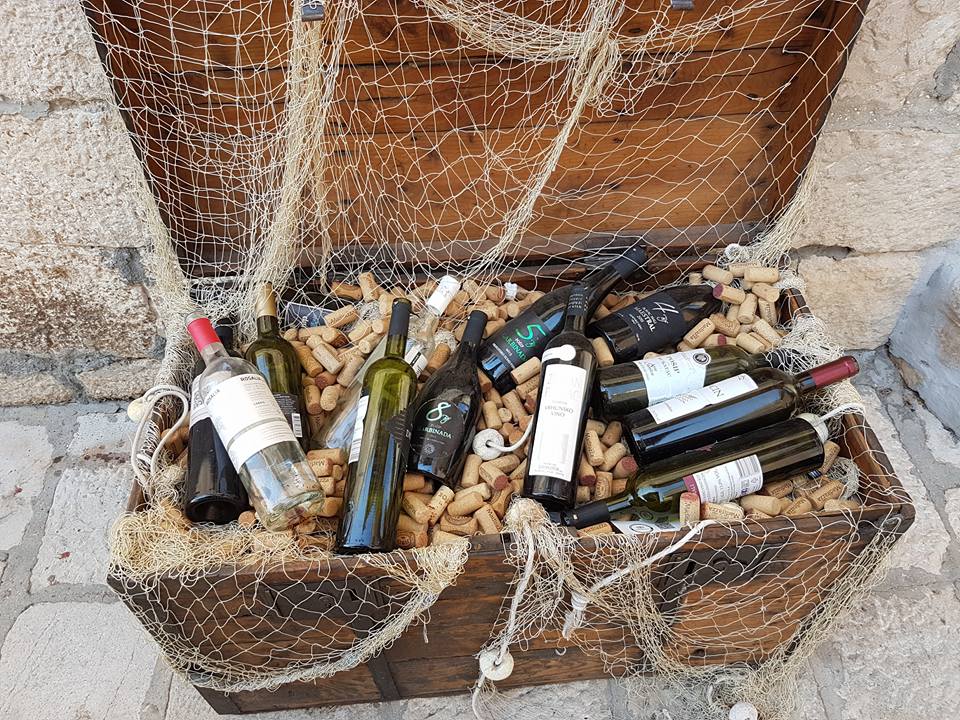
One of the strongest first impressions of my first visit to Korcula Town was how well the destination did in telling its visitors what its strengths were. Within seconds of entering the old town, you knew that this was an island of wine. And olive oil. And art. And culture. Whereas many Dalmatian seaside towns have opted to import cheap souvenirs from China, Korcula always strikes me as somewhere different in that respect, especially in the old town.
For this is an artisan town, with fabulous small shops celebrating local ingenuity and production, rather than cheap plastic souvenirs from the other side of the world.
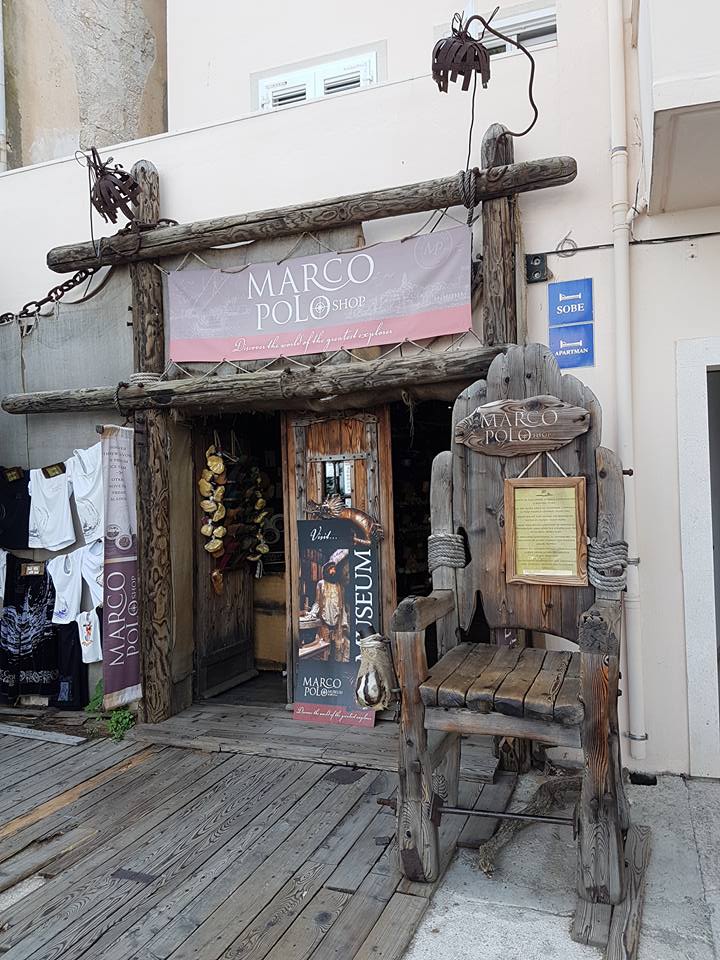
And while Kings Landing has Game of Thrones, Korcula is the birthplace of Marco Polo, a tourist image to cash in on, but one which Korcula does well - without cheapening the look and feel of the destination - want to get your Marco Polo souvenir? There is a dedicated shop for that, and the rest of the shops are given over to art and jewelry.
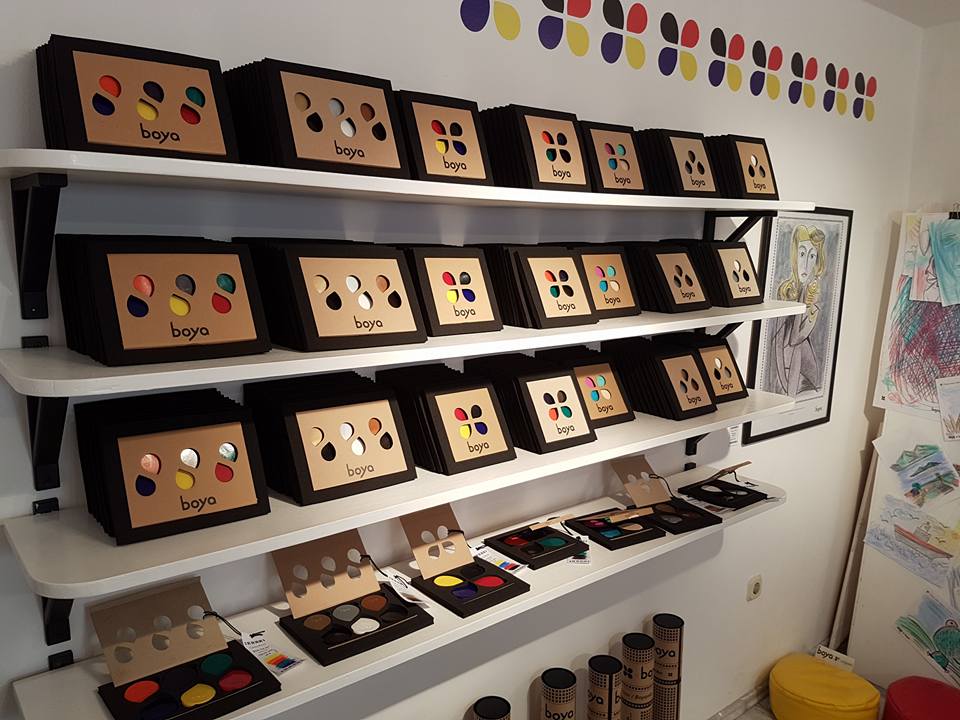
My favourite time to visit Dubrovnik is in the first week of February, for the celebration of the local patron saint, St. Blaise. Out of season, with most restaurants closed, their chairs, tables and awnings stored for the winter, the town is stripped back to its bare stone and is almost devoid of tourists. But the town is full, for this is a very popular local celebration.

Local traditions, local celebrations, family gatherings - it really is a privilege to be a foreign fly on the wall. You can learn more about magical Dubrovnik as its annual cultural height from my visit to the Festival of St Blaise a couple of years ago.
But that magical Dubrovnik is only a fleeting moment these days. Cruise ships, day trip buses, and more, more, more tourists has become the daily routine in the summer. So much so, in fact, that some local businesses are reporting worse revenue in July and August as the majority of visitors are low or non-spenders, and Dubrovnik's traditional wealthier clients stay away due to the crowds. Everyone loses except those in charge of the Tourism Numbers Bureau.
The obsession to pack more guests in and the desire to make as much money as possible manifests itself in various ways. Two of the things I love most about Korcula is the abundant breeze, so much so that I dedicated an entire article to it last summer.
And the second thing is Restaurant Row. One half of the old town's coastal path is given over entirely to restaurants. Aided by the wonderful breeze, an array of quality restaurants split their outside space between a few tables by the outer city wall and more tables by the restaurant itself. In between is a public walkway where tourists are free to roam. Day or night, it is an enchanting walk, and the balance between the historic buildings and the needs of tourism is just right. The photo below was taken close to midnight when most guests had gone, but you get a sense of the space.
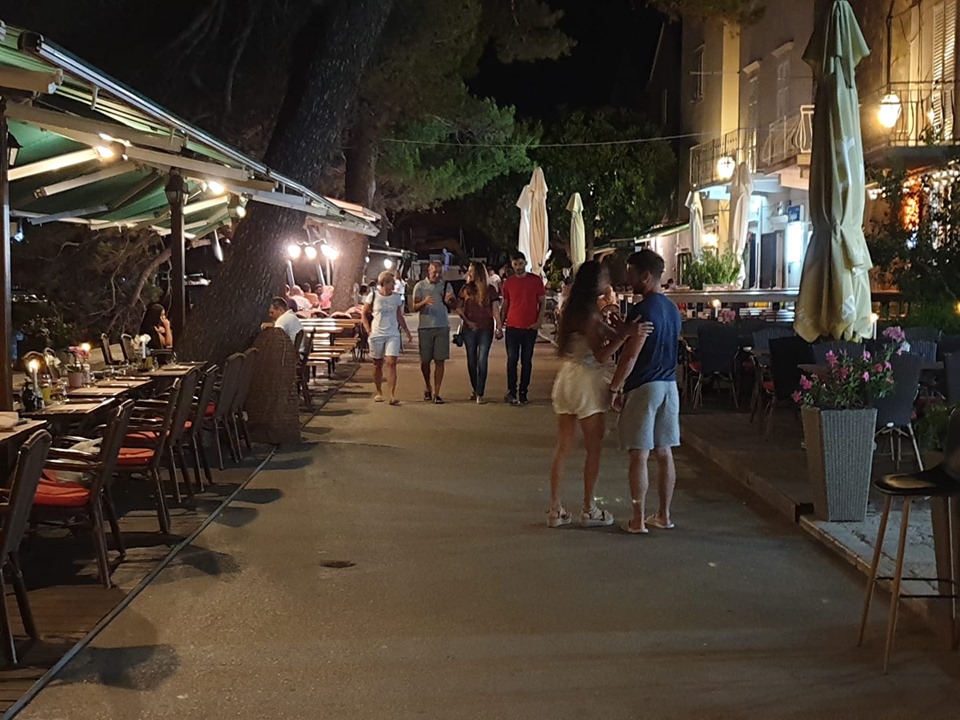
Meanwhile in Dubrovnik...
The magic of Dubrovnik, with everything stripped back to its stone origins, is glorious. Come back in July, however...
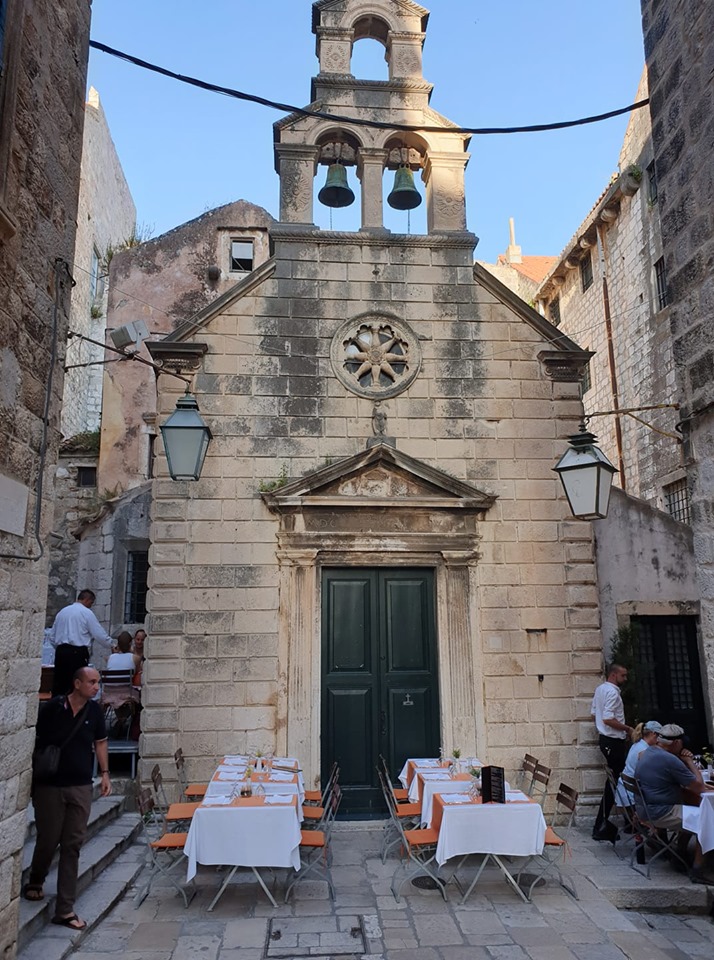
I posted this photo above on my personal Facebook page a few days ago with the caption 'Tourism meets the Catholic church,' and it provoked quite a reaction. Next to the Church of St. Nikola, which is only used about twice a year, an (apparently) very good restaurant with small inside space has come to an agreement with the Catholic Church, and they rent the space around the church to put tables there.
Some comments spoke of the quality of the restaurant and the fact that the church is never open. Others pointed out that churches were never built for the purpose of having restaurant tables around them when they were closed.
To me, the photo is a symbol of the difference between Dubrovnik and the so-called 'mini Dubrovnik.' Maximise the space for profit, get what you can. Never mind that somebody might have some to the city to revel in its incredible architecture. As a sightseeing tourist, walking along a street and seeing a church surrounded by restaurant tables tells its own story in how a destination values its treasures and chooses to promote them.
If you take the human factor out of Dubrovnik and Korcula, the case that Korcula is a mini Dubrovnik is strong. Add in the human factor, especially the obsession with packing as many people into the Pearl of the Adriatic, and there the comparisons end.
Korcula is one of the true jewels of Croatian tourism, moving along a path of quality tourism and doing everything well. Is Korcula a mini Dubrovnik? No, not at all.
But imagine what a destination Dubrovnik could be if it learned and implemented some lessons from its island neighbour. Mega Korcula could really make Dubrovnik shine.
To learn more about Dubrovnik, check out the Total Croatia Dubrovnik in a Page guide.
To learn more about Korcula, check out the Total Croatia Korcula in a Page guide.
And where else in the world can you have an early morning start to match this, above.
A Simple Plan to Contain Overtourism in Dubrovnik (and Elsewhere)
July 2, 2019 - The season of overtourism is in full swing in cities such as Venice and Dubrovnik. Some simple steps to improve the situation.
Overtourism is a little like the climate crisis. Everyone can see it happening (unless you are the Trumpster). Everyone can see it is getting worse and knows it will eventually kill the goose that lays the golden eggs. And nobody in authority is doing anything about it. And with so many people feeling comfortable and making money from it, there is little appetite for change from those in the tourism business because the money - for now - is good.
Would a tourism business support a move which might reduce overtourism a little but severely impact their business? In reality, there are exceptions, such as the laudable decision by Secret Dalmatia recently to refuse all future tours from cruise ship passengers. The move is not going to save the planet on its own and it will impact the agency's bottom line considerably, but a rare and commendable example of one small business making a stand. Most tourist businesses would rather protect their bottom line, which is understandable.
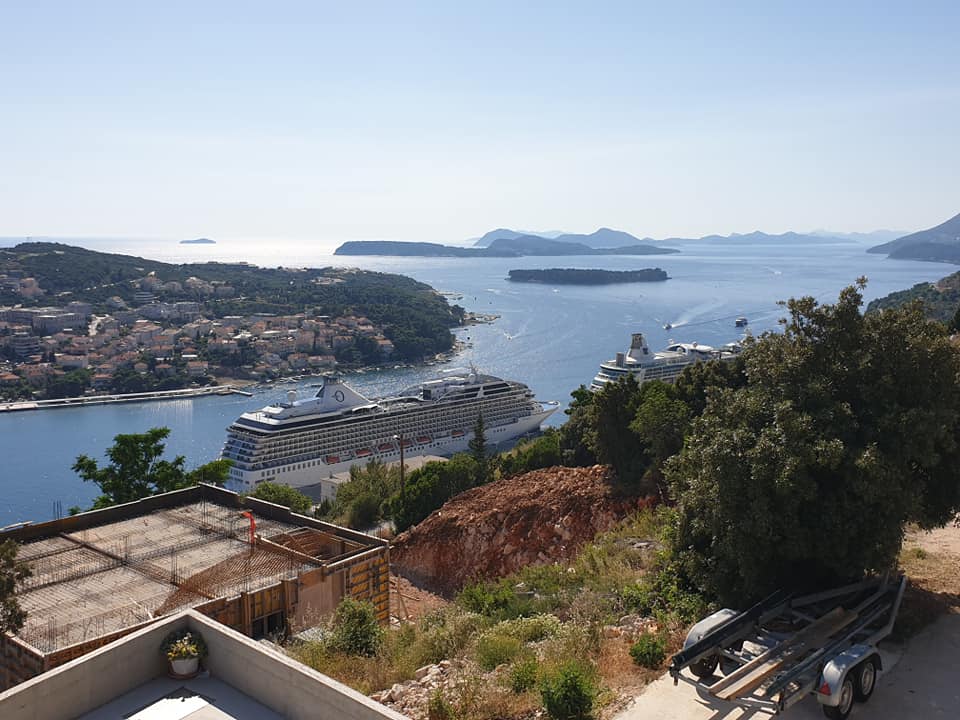
(Two cruise ships in Dubrovnik on Sunday)
It is the same with the climate crisis. A recent New York Times article, If Seeing the World Helps Ruin It, Should We Stay at Home?, could not put the issue more firmly in the locker of personal responsibility of each and every one of us:
Each additional metric ton of carbon dioxide or its equivalent — your share of the emissions on a cross-country flight one-way from New York to Los Angeles — shrinks the summer sea ice cover by 3 square meters, or 32 square feet, the authors, Dirk Notz and Julienne Stroeve, found.
In February, my family of three flew from New York to Miami for what seemed like a pretty modest winter vacation. An online carbon calculator tells me that our seats generated the equivalent of 2.4 metric tons of carbon dioxide.
Throw in another quarter-ton for the 600 miles of driving we squeezed in and a bit for the snorkeling trip and the heated pool at the funky trailer-park Airbnb, and the bill comes to about 90 square feet of Arctic ice, an area about the size of a pickup truck.
So now you can calculate how much you personally are contributing to the crisis, and there will be some who will react to these facts and not take that flight, but the majority will continue in their own short-term comfort zone. Our family holiday on the other side of the world is not going to make any REAL difference, surely?
And so, a little like climate change, the appetite to meaningfully tackle the problem of overtourism is weak. And yet if we don't, there will be no meaningful tourism experience in some of these destinations in just a few years. And please don't think I am preaching, I am the same as the majority.
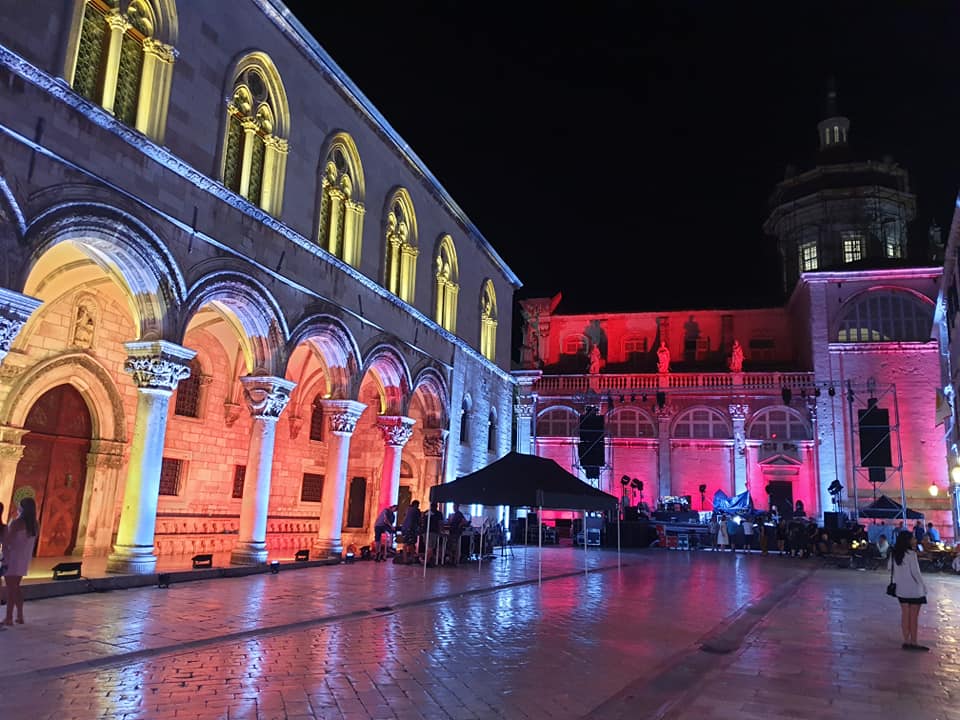
I have spent the last three weeks travelling around Croatia on assignments with TCN and family holidays. I have been to Varazdin, Zagreb, Zadar, Zut on Kornati, Split, Hvar, Korcula, Dubrovnik and currently in Montenegro. I have seen some truly divine places (Zut, Stari Grad and Korcula Town stand out) and some true horror shows, and the bigger Dalmatian cities of Dubrovnik and Split are already full. Too full, especially during the days when the numbers are swelled by day trippers and cruise ship passengers. It is simply not sustainable.
It is often said here that the locals would prefer it if the tourists sent the money and stayed at home, and while there might be an element of truth in that in some cases, what is happening increasingly is quite the opposite - tourists are coming and leaving their money at home. Day-trippers bringing their own sandwiches and water on day trips walking around top destinations without spending a penny (unless using the toilets). While they have a great cheap day out, their presence does little for the destination and adds to the overtourism issue with no benefit to the destination. A little like taking that family flight around the world and the climate crisis.
The view from Venice, from an interesting article from Responsible Travel on the subject.
Of the 20 million people who come to Venice each year, only half sleep here, which is why hotel stays have dropped by two thirds over the past 25 years. Many have poured off a cruise ship – on some days as many as 44,000 cruise passengers come to the city – or are on a whirlwind tour of Italy. Some stay for just a few hours, see little, buy a few trinkets and leave. They bring no economic benefit to the city in this way.
One aspect of tourism which is often overlooked is that many destinations are also living communities, where people live and work, and not necessarily in tourism. Tourism inevitably means compromise in a community - higher rents, less parking, more queues etc, and successful tourism works if the balance of tourism intrusion is matched by economic benefit - at least in my opinion. So if you have X number of tourists who are spending well and not upsetting the daily harmony very much, then you have a happy balance. If you have X number of tourists multiplied by three, many of whom are not spending, you have more than a small problem.
One Dubrovnik shop owner who sells jewelry told me this week that their business last year made more money in May and October than it did in either July or August. Crazy. So not only do the locals have to put up with the negative aspects of too many people in their community, it would appear - in some cases at least - that not only are they not benefitting from the increased numbers, but it is also hitting their bottom line. For the higher spending tourists are staying away from Dubrovnik in the peak season because it is too full.
Another business owner near the cable car (which started working again a couple of days ago) said that close to sunset, the number of visitors swells, as the view from the top is one of Dubrovnik's stated Instragrammable spots. There are several around the city and a growing number of visitors seemingly have this on their list of the only thing to do in Dubrovnik. If it is on Instagram, it happened. Never mind trying to experience the destination in any greater depth. Apart from the cable car ticket necessary for that perfect selfie, they are not providing anything except taking up oxygen.
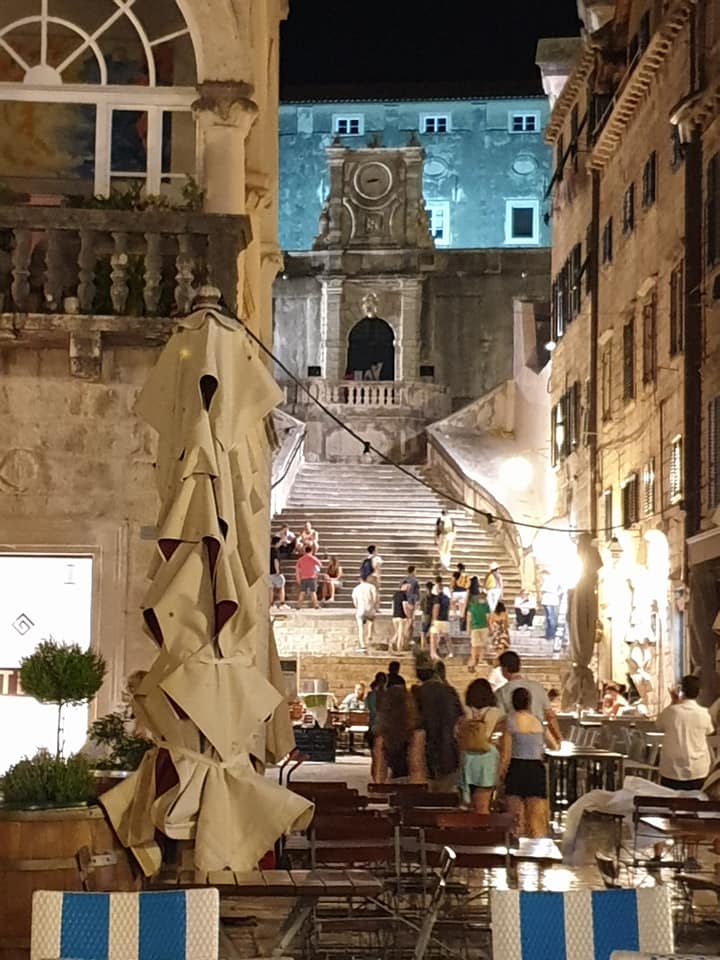
So what can be done to stop this overtourism and restore that balance between tourists and the community, and how to reduce the number of tourists?
The simple solution, of course, would be to ban all cruise ships and day trip buses, and you would probably solve the problem overnight. I am not advocating that, although a reduction in both would be a welcome step in the right direction. But how to encourage those visiting Dubrovnik to spend money and deter those who have no intention of doing so not to make the journey? I believe there are two simple ways which are fair and which would reduce the numbers considerably and help restore the community/tourist equilibrium.
The easiest way to effect the change would be through a smart voucher system. Entrance to the old town is only permitted if you are staying for a minimum of one night in Dubrovnik (cash into local pockets as well as an extended experience of the town after those Instagram moments), or by buying a smart voucher to the value of 50-100 euro per person. The exact number should be defined by someone cleverer than me. Locals are free. If the combined amount is too much for a family, come for a night instead and get the voucher that way. Cruise ships can build the voucher price into their overall price and ensure their passengers get the app. Any unspent money goes to the preservation of tourism sites, or similar.
Businesses in the old town are hooked up to the smart voucher and tourists can pay for their drinks and souvenirs via the voucher system, and the system then reimburses the individual business. That way, every tourist to the old town will spend money with local businesses, and those who are not prepared to do so do not come. Less tourists, more revenue, less overtourism.
Is it better to have 10,000 tourists a day spending 10 euro, or 1000 tourists spending 100, or 100 spending 1000 euro? Dubrovnik is a top, top quality destination which should be having an offer to match that. Rather than the ubiquitous cheap souvenir shops with cheap Chinese tat, increase the spend of the visitor by increasing the value of the offer.
But how will this work in practice? Setting up ticket offices and checking tickets to enter a living city would be a nightmare and cause lots of congestion. Thankfully (at least in this case), we live in the digital AI world, where technology can assist. I am not a techie, but someone smarter than me could make the following happen I am sure:
Vouchers are bought via an app (so no queues). Locals register for the app and are not charged. As tourists enter the old town, the system will notify the officials by the three entrances to the old town, and anyone entering without that notification will be politely stopped and asked to buy the voucher. Perhaps some targeted social media campaign with the threat of fines for entering without the voucher would be a good deterrent.
People with more experience in these things will be able to refine the idea in a more practical solution, but I don't see a better way to deal with overtourism than this without outright banning of things like cruise ships. Or does someone have a better plan, in which case leave in the comments below? It is an important discussion.
The other overtourism issue which is gaining increasing attention is the Airbnb-isation of cities and top tourist areas. Again, there is a simple solution where technology can assist, but one which will not be popular in some quarters. Simply limit the percentage of private accommodation which can be advertised on sites like Airbnb in certain areas. 10% in the city centre, for example. Controlling that by checking the online lists would be simple. It would require some legal work and the cooperation of the likes of Airbnb and Booking.com, but if we are all willing to work on the issues, they are solvable.
If there is enough will.
Why are Booking.com, AirBnB Croatian Occupancy Rates So Different?
June 27, 2019 - At the time of year when Croatian media focuses on how the season is going, some interesting discrepancies between Booking.com and AirBnB occupancy rates.
So how is the season? How are bookings? Will 2019 be another record year to beat the record year of 2018, which beat the record year of 2017? The record year of 2020 will beat the record year of 2019, but how do things stand in the world of reality away from the Kingdom of Accidental Tourism?
It is a topic I used to follow quite closely each summer, but not so much these days as my interest focus moves away from tourism. But I still have the conversations with people I meet, and the general verdict from the private accommodation sector is that booking are up to 20% down on the record 2018 and most will be happy if they get to within 5-10% of last year's numbers.
As I said, it is not a topic that particularly interests me these days, until that is...
Preparing for my latest business trip this week, I was looking for a one-night rental in Dubrovnik on Sunday, June 30. I started with AirBnB and was surprised by one thing and astounded by another.
I was surprised at how many private rooms and apartments were available for under £40 a night in this exclusive destination suffering from over-tourism just a few days before the peak season.
And I was astounded by the AirBnB statistic for my over night stay on June 30 (remember I was looking on June 27, just three days before):
32% of places in Dubrovnik for your dates and guests are already booked.
Which means 68% were not booked.
WTF? Had I stumbled across a story looking for the cheapest bed in the Pearl of the Adriatic for one night? It turns out that I had, butt not the one I thought I had.
The obvious place to counter check was Booking.com - and the picture could not be more different. While AirBnB was only 32% full, Booking was an impressive 87% occupied for Bradbury's visit to Dubrovnik on Sunday.
And, according to Booking.com, Dubrovnik was doing better than Split.
Which was doing better than Zadar. You can keep playing this game yourselves.
Just for fun, I chose a totally unpopular time to come in a destination I know well - Jelsa on Hvar. If you are thinking of visiting on December 15, then hurry, for Jelsa is 93% booked for this time of year when nobody visits.
So why the discrepancy?
I am sure that part of the reason to explain the high occupancy in Jelsa in December is down to the fact that the hotels are closed and so they simply block them off, and the Booking algorithm counts this as occupied. But even so - 93%?
Another partial explanation could be that Booking.com has a huge hotel database, whereas AirBnB is much more focused on private accommodation. Could it be that the Croatian hotel industry is doing extremely well and private accommodation very poorly?
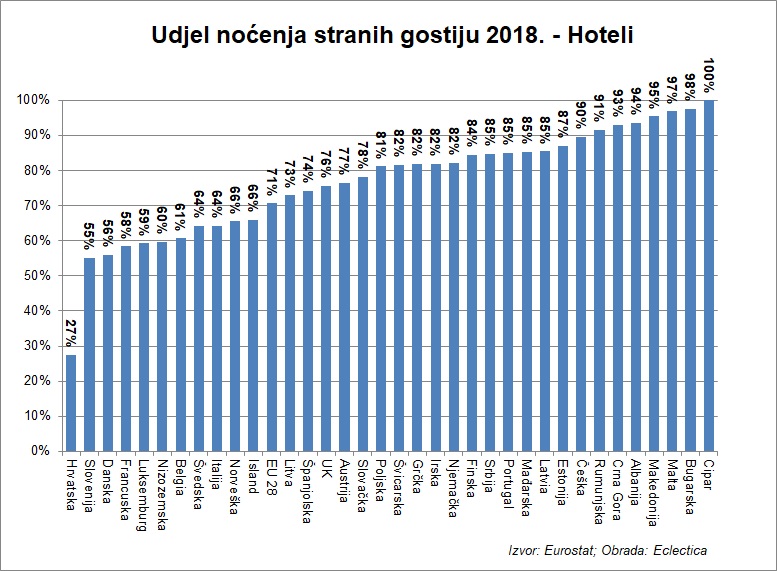
A very interesting article from leading Croatian entrepreneur Nenad Bakic, featured by TCN this week, showed a huge discrepancy between Croatia and the rest of the EU. As you can see from the charts above and below, hotel occupancy as a percentage of tourism accommodation is a third of the EU average.
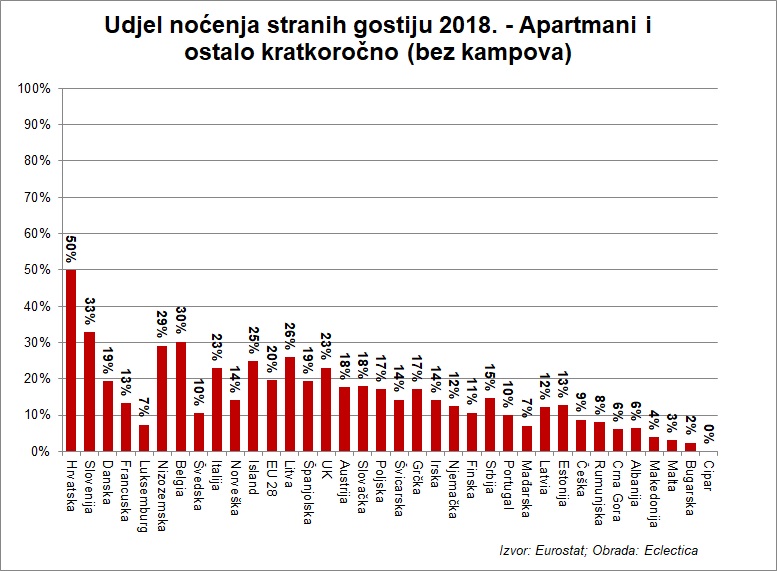
And with exactly half of Croatian tourism overnights coming from private accommodation (Slovenia is the only EU country which has more than 30%), could a lack of take-up of private accommodation this year (or better phrased, too much private accommodation on the market) be a large contributor to the lower AirBnB numbers compared to Booking.com?
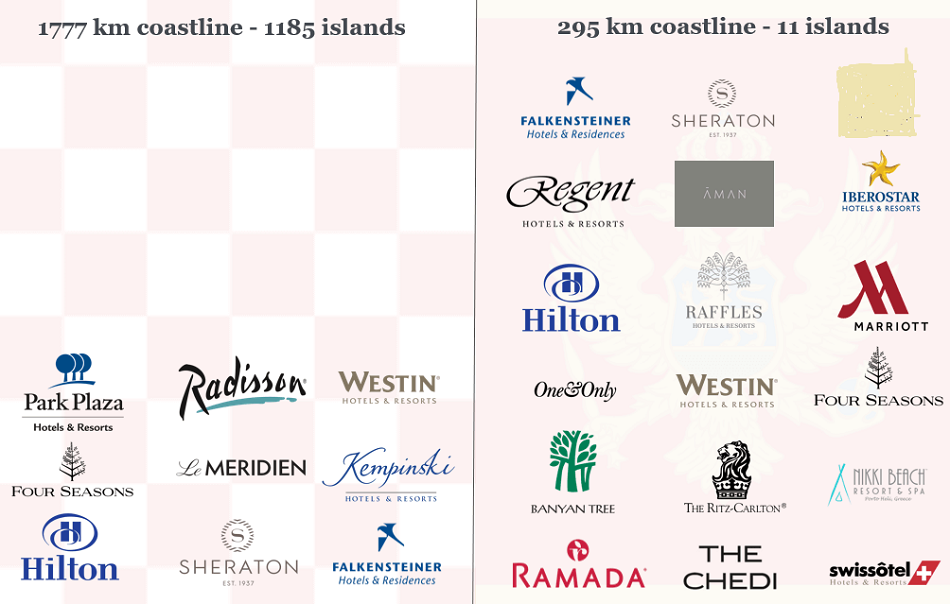
The higher Booking.com percentages may be due to the fact that Croatia's hotels are fully booking, but that is hardly surprising.
There are not nearly enough of them. As I explained at the recent Filipovic Real Estate Conference in Zagreb and Frei in Budva, the majority of the luxury international brands are avoiding Croatia, while they are queueing up to open in places like Montenegro.
A good season or bad? I have no idea if this will be the record season that official numbers will no doubt announce, or the disaster that many private owners predict. The only thing I can say with certainty is that with Jelsa 93% booked for December, our place is available, but book now!
Dubrovnik First in the World to Use Smart Parking
While Dubrovnik is often said to be unique and very special, it doesn't happen often that it can be said that it's the first and the best at something in the world.
However, the first and the biggest project of smart parking in the world has been being implemented in Dubrovnik over the last several months. Based on the newest generation of sensor networks and other necessary technologies, it covers most parking spots in Dubrovnik, Leona Rašica writes for dulist.hr.
Tomislav Tabak, the director of the Sanitat, Dubrovnik's utility services company, explains that the smart parking project has managed to include everything: the physical parking spots around the town, the application which will be used by the citizens of Dubrovnik and tourists to find the closest available parking spot, and the ease of purchasing parking tickets more.
The project is currently in its final stage, as over 1,900 sensors have been installed on the parking spots around the town. All of those have been repainted and numbered, so it's easy to identify each spot through the application. They need to finish installing sensors on some of the spots, but that too should be finished by July the 1st. The entire system cost 3.1 million kuna, along with three years of maintenance and support.
The project is supposed to be in the service of the users, helping them find parking spots, making that process faster, navigating them to the spot, which director Tabak hopes will lead to the reduction of the traffic jams in Dubrovnik during the tourist season.
The application will be free, easy to use, and user-friendly and it'll be possible to pay for parking through the application itself. Once the project starts, the application will be updated to provide the functionalities that have been overlooked in the initial implementation. The NBIoT (Narrowband Internet of Things) standard will be used, which has become the go-to technology worldwide for similar projects.
A similar project was started in Dubrovnik in 2015 after the Strategy of the development of the Smart Town of Dubrovnik was adopted. Unfortunately, that project was abandoned because some of the basic ideas from the Strategy were overlooked. Now it seems that everything that needed to be done has been done successfully, the funds were found and the smart parking project in Dubrovnik will soon bring the newest technology to the streets of an ancient town.
For more Dubrovnik news, go to TCN Destination Dubrovnik page.
Dubrovnik's War on ATMs Sees Auro Domus Preparing to Sue the City?
Recently, we reported on the City of Dubrovnik's apparent victory in its fight against cash machines in its historic core, but did we speak too soon?
As Novac/Filip Pavic writes on the 21st of June, 2019, it seems that the Pearl of the Adriatic's fight against the machines has taken a turn for the worse.
''If anyone tries to remove the cash machines or enter private property without authorisation, Auro Domus will take legal steps to protect its business and the business of its partners, local retailers and tradesmen,'' said Loris Dessardo, the owner of the Croatian company Auro Domus, following the announcement by Dubrovnik's local authorities at the beginning of the week that machines in the historic core of Dubrovnik have to be removed within thirty days.
The conflict between the irritated residents of Dubrovnik and the local government has also got another factor to take into consideration, the Croatian company Auro Domus from Opatija, which has placed more than 400 ATMs throughout the country over the past year, and citizens of certain area's aren't remotely happy.
Dubrovnik's citizens have stood up against the placement of the cash machines, when forty such machines were placed along the old city's famous Stradun, claiming that they violate the identity and view of the city's historic core, but the owner of Auro Domus has insisted that this isn't a valid argument for their removal.
"So, on the one hand, we have measurable benefits for Dubrovnik, its inhabitants and for the economy, and on the other hand, the subjective aesthetic criterion of individuals who don't like what they look like in the city. And now the City Council try to incorporate this aesthetic criterion into its decision?'' Dessardo stated.
Dubrovnik's mayor, Mato Franković, did just that.
On Tuesday, the City Council of the City of Dubrovnik sent a proposal for amendments to the decree on communal order. According to these changes, the owners of the premises who have agreed to allow the cash machines' placement there, and for which they receive up to 12,000 kuna in compensation, must obtain the approval of the Ministry of Culture's conservationd department if they don't want the ATM to be removed. According to Dessard, this is ''an illegal attempt to interfere with economic activity".
''The law clearly prescribes the powers of local self-government units. These powers relate to the facades of the buildings, and the ATMs set up by Auro Domus aren't on the facades, but in the interior of the business premises, and for their installation, no building permits are needed,'' emphasised Dessardo, citing several articles of law related to this particular matter.
''The biggest absurdity of the whole story is that the City of Dubrovnik is trying to ban one of the most important tourist activities. The money that tourists withdraw from the cash machines is the money that stays in that local government unit and will be spent in Dubrovnik's cafes, restaurants, shops,'' concluded Dessardo.
Follow our dedicated lifestyle page for much more. If it's just Dubrovnik and the extreme south of Dalmatia you're interested in, give Total Dubrovnik a follow, or check out Dubrovnik in a Page for all you need to know about the Pearl of the Adriatic.
Flights to Croatia: Iberia Ends Dubrovnik Winter Service, Boosts Zagreb Instead
June 19, 2019 - The latest news from around Croatia’s airports for new flights to Croatia with updates from Dubrovnik, Zagreb, and Pula.
Ex Yu Aviation reports on June 19, 2019, that the national airline of Spain, Iberia, will end its winter service between Madrid and Dubrovnik but will maintain its summer service. Recall, Iberia operated between Madrid and Dubrovnik two times a week last winter season.
However, not all hope is lost for Croatia this winter, as the Spanish airline will instead increase operations to Zagreb to three flights per week. The additional service will operate on Sundays.
Iberia has shown Croatia quite a bit of love this year, which all started with them adding another 204,586 seats between Spain and Croatia compared to last year.
"Most of our passengers to and from Croatia fly point to point, but we also have connecting traffic. Among the cities that feed more passengers to our flights from/to Dubrovnik, Split and Zagreb last year were New York, Lisbon, Bilbao, Porto, Chicago, Boston, and Miami,” Iberia said to Ex Yu Aviation at the beginning of the year. You can read the story here.
In other news, Avio Radar reports that for the first time in its history, Pula Airport welcomed two Boeing 787 Dreamliner aircraft at the same time. Namely, on Tuesday, June 18, two British airline TUI Airways aircraft flew on the BY4278 route from London Gatwick Airport and the BY2206 route from Manchester after 12:20, just three minutes apart.
The Boeing 787-9 G-TUIM airplane flew from London, while the smaller Boeing 787-8 G-TUII flew from Manchester. The two flights did not plan on arriving in Pula at the same time, though the plane from Manchester was three hours late.
On May 23rd this year, Dubrovnik Airport welcomed three Boeing 787 Dreamliner aircraft at the same time, from London, Manchester, and Bristol.
To read more about travel in Croatia, follow TCN’s dedicated page.
Dubrovnik Residents Win Battle Against ATM's in Historic Old City
For a while now, Dubrovnik's residents have been complaining of the over-commercialisation of the city. This UNESCO World Heritage site has become a bit of a Disneyland of late, partially because of the Game of Thrones gravy train and partly because of cruise ships and other daytrippers who contribute to the ''cheapening'' of the destination.
While nobody can argue that the city itself is cheap (quite the opposite, although there are actually numerous notable exceptions), one thing that contributed to this unwanted image was the placement of far too many ATM machines in no less than the heart of the Old City, precisely the area protected by UNESCO.
Not only does the placement of far, far too many cash machines in the heart of this beautiful, Medieval city look crass, but it causes yet more disturbance to the few people who continue to live within the walls, the number of which has dropped significantly since the 1990's. It seems however, that Dubrovnik's residents have won their anti-ATM battle, and the machines must now be removed within a thirty day period.
As Poslovni Dnevnik writes on the 18th of June, 2019, although the influx of ATMs are indeed located in private areas, they're placed on Dubrovnik's ancient and beautiful facades, and they're distorting the look of the old buildings along Stradun and in other parts of the ancient Old City.
In accordance with the desire of the Ministry of Culture of the Republic of Croatia, Dubrovnik Mayor Mato Franković sent a proposal to the Council of the City of Dubrovnik to amend the decree on municipal order.
According to the proposed modifications for the openings of buildings located in the historic core of the City of Dubrovnik, it is forbidden to set up ATM machines as well as other devices, as well as advertising cabinets, writes the local portal Dubrovački portal.
Regarding the existing ATM machines already placed in Dubrovnik's historical core, it has been established that these machines must now be completely removed within thirty days from the date of entry into force of the decision if the owner/user of the space hasn't managed to obtain the appropriate consent or approval from the Croatian Ministry of Culture's conservation department.
In the face of too many cruise ships and their excessive pollution, overcrowding, the semi-collapse of the city's old and incapable infrastructure and endless traffic jams, it seems that the citizens of Dubrovnik have finally had their day, at least in this instance.
Make sure to follow our dedicated lifestyle page for much more. If it's just Dubrovnik and the extreme south of Dalmatia you're interested in, give Total Dubrovnik a follow or check out Dubrovnik in a Page for everything you could possibly need to know.
Flights to Croatia: Aegean Announces New Winter Line to Dubrovnik
June 15, 2019 - The latest news from around Croatia’s airports for new flights to Croatia with updates from Dubrovnik and Zagreb.
Avio Radar reports that Greek carrier Aegean Airlines, a member of the Star Alliance association, will maintain their summer route between Dubrovnik and Athens for the winter, thus giving Dubrovnik a new line this winter season.
From October 28, 2019, the Aegean route will operate twice a week, on Tuesdays and Saturday, until January 4, 2020. Afterward, there will be a two-month winter break, and from March 3, 2020, traffic will continue with two flights per week.
At the same time, the Greek airline will increase winter traffic on the Zagreb-Athens route. In addition to last year’s two flights a week, on Mondays and Wednesday, an additional third flight will be introduced on Thursdays at selected times during the winter period.
Just like the Dubrovnik route, the Zagreb route will have a break in traffic this winter, but for a shorter amount of time - from January 16 to February 23, 2020.
Both lines will operate using the Bombardier Q400 aircraft from the Greek Olympic Air fleet.
In other news, Avio Radar also reports that the Austrian low-cost carrier Anisec Luftfahrt, flying under the marketing name LEVEL, has significantly reduced traffic on many of its European routes. This significant reduction in traffic has also influenced the only route in Croatia, between Vienna and Dubrovnik, which was scheduled for four flights per week.
Now, the line will operate just one flight per week this summer, on Saturdays. Traffic will end on this route on September 7, 2019, with no further sales. An Airbus A321 aircraft will fly on this route.
To read more about travel in Croatia, follow TCN’s dedicated page.






